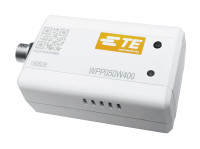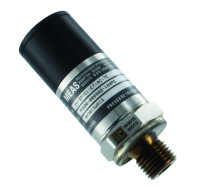Q&A with Pete Smith: On New Sensor Solutions for the Industrial Internet of Things (IIoT)
on
Accurate, reliable sensors (e.g., position and temperature) are key component for the Industrial Internet of Things (IIoT) applications. Pete Smith (Senior Manager, Sensor Product Knowledge and Training, TE Connectivity) tells us about fascinating new sensor products and shares his thoughts on the future of the IIoT.

Sensor Product Knowledge
and Training, TE Connectivity)
Pete Smith: I came to TE through the acquisition of Measurement Specialties in 2014. However, I’ve been involved with sensors and the sensor industry since 1971 (47 years). I’ve worked in product engineering, manufacturing/operations, and sales/marketing throughout those years gaining knowledge and expertise in a wide variety of sensor products and technologies.
C. J.: What are you currently working on?Pete: Today, I’m the senior manager of TE’s product knowledge and training group where we prepare and present content used to train employees and support various functions within the division. We also provide services to the TE marketing team to support the campaigns they prepare for live presentations, new product introductions, print, web-based, social media-based, and digital marketing.

Pete: Some in the industry use the terms interchangeably. There are distinctions, however. IIoT is a subset of the “Internet of Things” (IoT). IIoT focuses on applications that occur on factory floors and in manufacturing settings. IoT generally addresses the ubiquitous interconnection of consumer products, smart home, wearables, and commercial applications where a failure doesn’t result in a critical or emergency situation. IIoT does the same in the manufacturing space but with focus on data transfer, management of mission critical information, and low latency (instant) reactions and responses. Accuracy, reliability, and timeliness are absolute requirements for IIoT systems as failures can result in substantial material losses, financial losses, and compromised safety to the operators and owners. Industry gathers around IIoT. Industry 4.0, on the other hand, is a governmental initiative (started in Germany) whose objective is to protect and promote all manufacturing industries. IIoT implementation is just one aspect of their efforts. They also work on making the regulatory landscape more friendly, smoothing labor relations, presenting and promoting new technologies and management techniques, among other efforts. IIoT is being driven by corporate interests, while Industry 4.0 is being driven by institutional and governmental interests.
C. J.: What trends are you seeing in Industry 4.0 for sensors?
Pete: The IIoT part of Industry 4.0 focuses on real-time data-driven decisions made in a factory setting with the objective of improving efficiency, utilization, and yields. All this is accomplished by collecting and analyzing data from machines and equipment on a factory floor. The data is then used as the basis for analytics where results and outputs are generated and routed back to the factory floor. This information is applied to the same machines and equipment, altering their operation to achieve the desired improvements. All the front-end data is supplied by sensors, and as such, the addition of sensors to factory equipment is starting to emerge as a major new market. We currently estimate that sensor sales will grow at CAGR of 5% to 10% through 2025 in IIoT applications.
C. J.: Tell us a bit about TE Connectivity’s Industry 4.0 customers.Pete: Some of the areas where we’re starting to see traction are: remote inventory management in gas and air tanks; petroleum well-head monitoring; remote water- and liquid-level monitoring; gas meters for energy transportation; factory machine condition monitoring to drive periodic maintenance and reduce downtime; and factory infrastructure to monitor shared services (compressed air, vacuum, chilled water).
C. J.: What is involved with assisting customers with retrofitting existing equipment? Is it a long process from sale to completion?Pete: Most customers determine on their own what factory parameters they want to monitor. They then come to us for assistance in selecting the best sensor solution. Actual installation of sensors on the factory equipment can take time because the equipment must be shut down during sensor installation and most factories can’t do without critical equipment for long periods of time. Retrofit requires planning.
C. J.: Which requirements are you finding relate to customers who work with existing machinery and processes?
Pete: Customers require sensors to be extremely rugged, reliable, accurate, and able to survive harsh environments. Equipment failure can be catastrophic on a factory floor, and there are no margins for errors.
C. J.: Even if customers are not fully implementing IIoT, do you see sensors still playing a role in Industry 4.0?
Pete: In general, yes. Factory operators may want to implement IIoT concepts and systems on a highly localized level where they might be monitoring just a portion of a production line, or even one critical machine on the line. IIoT principles are highly scalable in either direction. You can go smaller or bigger.
C. J.: How are you designing sensors to work in Industry 4.0 even though customers are at different stages of maturity?
Pete: TE Sensor Solutions has focused on sensor products that are designed for harsh environments, high reliability, and accurate performance. Because of this, many of our current products easily fit into IIoT applications without any modifications or changes.
C. J.: TE develops Industry 4.0 sensors for a variety of uses, specifically predictive maintenance, asset monitoring, building automation, process automation, and security. Which of these five areas has delivered the most business during the past year?
Pete: Over the past year, process monitoring and automation has produced the most revenue.
C. J.: Are there any new TE Connectivity sensors or technologies you’d like to share with us?
Pete: There are two areas where we are focusing. Multi-sensor modules — where several sensor technologies are contained in a single enclosure (Figure 1). Often, factory monitoring requires the collection from several data sources — pressure (Figure 2), temperature, force, position, etc. — from a machine or process. Offering a single sensor package with several unrelated capabilities inside provides the user with lower installation and operation costs. Wireless sensors — TE has just introduced a small group of wireless sensors designed specifically for factory equipment monitoring. Wireless capability dramatically reduces installation costs on a factory floor and provides improved flexibility when a machine or process must be moved or modified in some way.

C. J.: Where is the Industry 4.0 revolution heading? What’s next?
Pete: Serious IIoT is starting to get traction now. More companies and industries will implement systems and report results, and if positive, there will be a stampede to IIoT in a few years. Today, from a supply perspective, IIoT hardware and services are fragmented. Many companies are offering only parts of a complete IIoT solution. Going forward, there may be some consolidation with IIoT suppliers. Some companies will be able to offer turnkey capabilities to customers. (There are none now.) Factory machine manufacturers will begin to offer “IIoT Ready” equipment already populated with the latest sensor technologies. The good news for TE Sensor Solutions is that sensors are hard, we’re good at them, and there will always be a need for our products no matter how the industry changes and evolves.
You can read the entire interview in Elektor Business 5/2018, which is slated for publication in September 2018.


